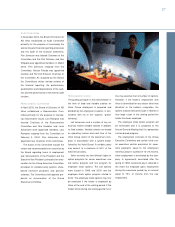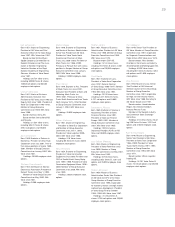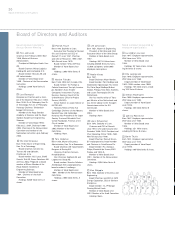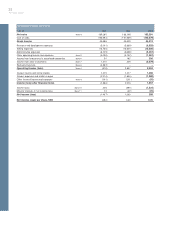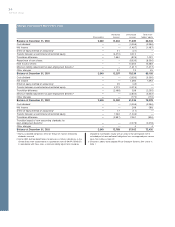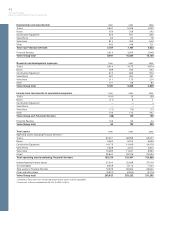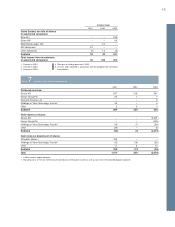Volvo 2003 Annual Report Download - page 38
Download and view the complete annual report
Please find page 38 of the 2003 Volvo annual report below. You can navigate through the pages in the report by either clicking on the pages listed below, or by using the keyword search tool below to find specific information within the annual report.
36
The Volvo Group
Notes to consolidated financial statements
Disclosure and Presentation, which conforms to a large extent with
IAS 32 issued by the IASC. The adoption of RR 27 has affected the
balance sheet presentation of certain derivative instruments that are
used to manage financial risks related to financial assets and liabil-
ities. In accordance with RR 27, derivative instruments with unreal-
ized gains are to be presented as assets and derivative instruments
with unrealized losses are to be presented as liabilities. In accord-
ance with Volvo’s earlier accounting principles, derivative instruments
used for management of financial assets were reported as assets
and derivative instruments used for management of financial liabilities
were reported as liabilities. As a consquence of adoption of the pres-
entation principles in RR 27, the Volvo Group’s assets at December
31, 2003, increased by SEK 3.6 billion and the Group’s liabilities
increased by the corresponding amount. In accordance with the tran-
sition rules of RR 27, no restatement has been made of figures for
prior years.
As of 2003, Volvo has also adopted RR 22 Presentation of
Financial Statements, RR 24 Investment Property, RR 25 Segment
Reporting — Sectors and Geographical Areas, RR 26 Events after
the Balance Sheet Date and RR 28 Government Grants. Certain
changes have been made in the structure and content of the finan-
cial information in this annual report as a result of these new stan-
dards. However, the standards listed above have not resulted in any
changes of the measurement of the Group’s financial performance
or position.
Future changes of accounting principles
Effective in 2005 Volvo will adopt International Financial Reporting
Standards (IFRS) in its financial reporting. The transition from
Swedish GAAP to IFRS is being made to implement a regulation
applicable to all listed companies within the European Union as of
2005. Because revised IFRS’s are expected to be issued during
2004, the total effect of this change of accounting principles cannot
be determined with certainty. Volvo considers, however, that the most
significant effects will pertain to the accounting for financial instru-
ments and goodwill. Restatement of figures for prior years will be
made in accordance with the requirements of the transition rules.
During 2003 Volvo has started a number of projects aimed at adapt-
ing the internal reporting routines to the new regulation. More
detailed information about the IFRS transition effects will be
presented in connection with the publication of the 2004 financial
reports.
Consolidated financial statements
The consolidated financial statements comprise the Parent Company,
subsidiaries, joint ventures and associated companies. Subsidiaries
are defined as companies in which Volvo holds more than 50% of
the voting rights or in which Volvo otherwise has a controlling influ-
ence. However, subsidiaries in which Volvo’s holding is temporary are
not consolidated. Joint ventures are companies over which Volvo has
joint control together with one or more external parties. Associated
companies are companies in which Volvo has a significant influence,
which is normally when Volvo’s holding equals to at least 20% but
less than 50% of the voting rights.
The consolidated financial statement have been prepared in
General information
Amounts in SEK M unless otherwise specified. The amounts within parentheses refer to the two preceding years; the first figure is for 2002
and the second for 2001.
Note 1Accounting principles
The consolidated financial statements for AB Volvo (the Parent
Company) and its subsidiaries have been prepared in accordance
with generally accepted accounting principles in Sweden (Swedish
GAAP). Accounting standards and interpretations issued by the
Swedish Financial Accounting Standards Council have thereby been
applied. Swedish GAAP differs in significant respects from US
GAAP, see further in Note 35.
In the preparation of these financial statements, the company
management has made certain estimates and assumptions that
affect the value of assets and liabilities as well as contingent liabilities
at the balance sheet date. Reported amounts for income and
expenses in the reporting period are also affected. The actual future
outcome of certain transactions may differ from the estimated out-
come when these financial statements were issued. Any such differ-
ences will affect the financial statements for future fiscal periods.
Changes of accounting principles in 2003
RR 29 Employee benefits
As of 2003, Volvo has adopted RR 29 Employee Benefits in its
financial reporting. RR 29 Employee Benefits, which was issued by
the Swedish Financial Accounting Standards Council in December
2002, conforms in all significant respects with IAS 19 Employee
Benefits issued earlier by the International Accounting Standards
Committee (IASC). By applying RR 29, defined-benefit pension plans
and health-care benefit plans in all the Group’s subsidiaries are
accounted for by use of consistent principles. In Volvo’s financial
reporting up to 2002, such plans have been accounted for by apply-
ing the local rules and directives in each country. In accordance with
the transition rules of the new standard, a transitional liability was
established as at January 1, 2003, determined in accordance with
RR 29. This transitional liability exceeded the liability recognized as
per December 31, 2002, in accordance with earlier principles by
approximately SEK 2.3 billion. The excess liability consequently was
recognized as at January 1, 2003, as an increase in provisions for
pensions and other post-employment benefits and a corresponding
decrease in shareholders’ equity. No additional deferred tax asset
was recognized in the Group’s balance sheet as at January 1, 2003,
attributable to the transition liability. In accordance with the transition
rules of the new standard, Volvo has not restated figures for earlier
years in accordance with the new accounting standard. Because the
Group’s subsidiaries up to 2002 have been applying local rules in
each country, the impact of adopting RR 29 as of 2003 differs for
different countries of operations. Compared with earlier accounting
principles in Sweden, the adoption of RR 29 has mainly had the
effect that plan assets invested in Volvo’s Swedish pension founda-
tion as from 2003 are accounted for at a long-term expected return
instead of being revalued each closing date to fair value. For Volvo’s
subsidiaries in the US, differences relate to accounting for past serv-
ice costs and the fact that RR 29 does not include rules about mini-
mum liability adjustments.
RR 27 Financial instruments: Disclosure and presentation
Effective in 2003, Volvo has adopted RR 27 Financial Instruments:



